GLAM Campers Explore Materials, What Studying Materials Engineering is Like
July 31, 2019
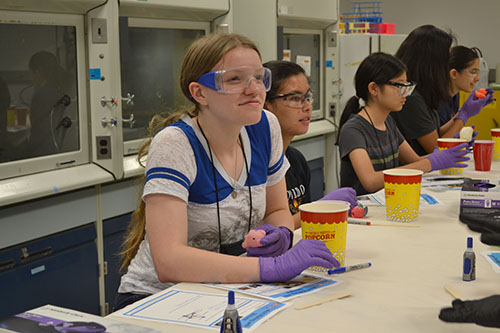
GLAM campers listen to instructions about how to make a mold. (Image courtesy of I-STEM undergrad Sooah Park.)
Eighteen female high school students from Illinois, and even a couple from the east coast (New Jersey and Connecticut) were on campus the week of July 7–13 to participate in the 2019 edition of Girls Learn About Materials (GLAM). In addition to learning about a variety of different materials, teams of students completed design projects targeting specific materials, during which they learned more about their material and even designed a prototype using it. They also honed their presentation skills by creating and presenting a poster at the end-of-the-week poster session. A final goal of the camp was to foster interactions between the campers and female students majoring in Materials Science.
Some of the myriad materials the girls learned about during the week included polymers, composites, crystallography, non-Newtonian fluids, biomaterials, and even one material most girls particularly love—chocolate! Plus they experimented with various materials’ conductivity, how they fracture, and how solar cells work. They even did some 3D printing.

A camper puts some finishing touches on her team's poster.
In addition to activities exposing campers to various materials, the core component of the week was a design project, where teams of girls explored a specific, everyday material, such as glue, cardboard, malleable metal (tin foil), tape, or plastic, to come up with a use that’s different from how it’s normally used. They created both a prototype of their product and a poster about their process, which they presented during the Friday poster session.
In relation to the design project, the GLAM camp coordinator, Materials Science and Engineering (MatSE) Assistant Professor Jessica Krogstad and her students are in the third year of a longitudinal study looking at how design thinking is incorporated into outreach camps and how that impacts campers’ perspectives about engineering, especially about their own ability to be an engineer or be active in STEM areas.
Because of the study, a lot of the GLAM activities have remained the same over the last few years. “So in terms of the other camp content, we’ve been trying to keep it pretty consistent so that we can make these comparisons from year to year as we’re learning more,” Krogstad says.
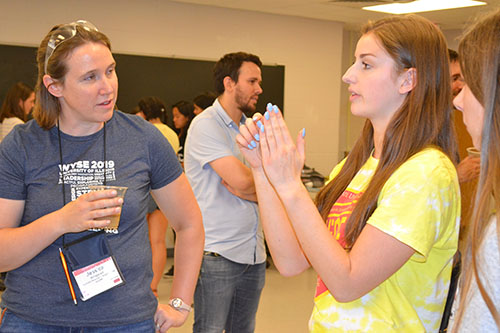
Jessica Krogstad (left) listens as a camper discusses her team's project during the Friday afternoon poster session.
She adds that the results of the study are promising, indicating that there are several different ways to incorporate design effectively. “But those camps that we’ve studied that don’t have significant design components don’t have the same positive responses as the camps that we have studied that do have a big design component involved in the camp.”
Based on their research, some camps have competitive design projects where teams compete against each other, while other design projects are very individual. GLAM’s design project is very open-ended and team-based. “So we give them a pile of materials and we say, ‘Make something, and justify why you make it based on the material’s properties.’”
Krogstad says GLAM’s design project leaves both the end user as well as the actual scope up to the students. The goal is for campers to explore their material’s properties and functionality. “And we’re really allowing them to bring their own experiences and their own interests in defining the user groups and what exactly they want to make,” she says.
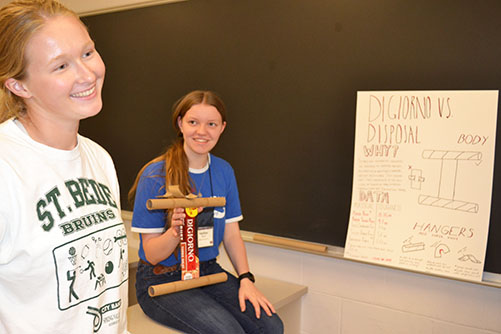
Students in the Cardboard Group present their poster, Digiorno Vs. Disposal, and the prototype hanger they designed which repurposes cardboard.
For instance, in the past, some campers “have really gotten excited about helping one particular community that they were passionate about," Krogstad explains. "Others were just like, ‘Well, this sounds fun and cool, and I want to make something like this!’ And so we’ve allowed them to go with that and really take ownership over their project. And I think it’s been very positive. They’re always very excited to show their parents their design projects.”
However, GLAM is more than just learning about materials; campers also benefit through their interactions with the college students. “So it’s, I think, really important for the campers to talk and interact with undergraduates as well,” Krogstad says.
In fact, because she believes these interactions are so meaningful, one new activity included in this year’s program was an interactive panel with undergraduate students, designed to give campers the opportunity to find out more about why students had chosen to major in materials in college, and what it’s like studying the field. So on Tuesday July 9th, several undergraduate students participating in the I-MRSEC REU (Research Experience for Undergraduates) shared with campers about their experiences and why they’re interested in material sciences.
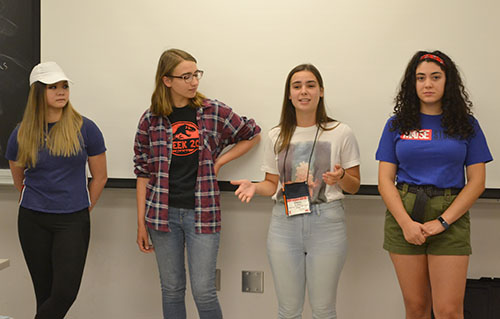
Students on the undergraduate panel share with campers what studying materials engineering is like. (Image courtesy of I-STEM undergrad Sooah Park.)
What kind of impact did the camp have? Besides learning a lot about materials, GLAM campers also discovered that Illinois is a great place to study them. In fact, Krogstad admits that recruiting students to Illinois is one of her main goals: And so I’m excited just to see a new batch of campers, and then see them again in the fall—this fall or the next fall. That’s our ultimate goal.”
While the campers definitely benefitted, Krogstad claims that GLAM is a win-win for everyone involved—not just campers. For example, she personally finds GLAM to be extremely rewarding. One reason she does the camp every year is because she loves interacting with the students. She admits that it’s a lot of work. (In fact, she actually calculated the amount of work the camp takes last year, and reports that it’s the same number of contact hours as a three-hour, full semester class!)
However, since teaching is one of her favorite things to do, and since she doesn’t teach in the summer, GLAM and other outreach activities, such as the half-day session in the WYSE Explore Your Options camp she had done the previous week were her only chances to teach. While she calls WYSE “fun,” she says it’s a different dynamic than GLAM.

Jessica Krogstad works with a student creating a solar cell.

GLAM campers extracting DNA from strawberries during the Biomaterials session. (Image courtesy of I-STEM undergrad Ryan Kim.)
“Because I didn’t know any of the students, and I didn’t have a chance to get to know any of the students or really engage with them…One-on-one interaction with the students is so much different.”
Krogstad acknowledges that getting to know her campers is one of the most rewarding things about GLAM. In fact, some relationships last past the summer and develop into long-term relationships as ex-GLAM campers matriculate to Illinois to seek degrees in MatSE. In fact, Krogstad says that at least a couple of students who participated her camp are present in every class she teaches at Illinois.
“Now I see them as sophomores, and I actually know them really well…Even if it’s just one or two every year—I know that’s not a big number—but it feels like a significant impact to me. That’s why I do it every year.”
And campers who matriculate to Illinois because of GLAM appreciate their relationship with Krogstad too. In fact, this year they actually gave her a little pig. (Evidently MATSE has this tradition involving little pig trophies.) “I don’t know,” she says regarding how it came about, “It’s a very long tradition. But, yeah, this year they gave me a little pig because they met me in GLAM, and they were so excited, and they came.”
In fact, although none of her ex-GLAM-camper undergraduates were able to help out with the camp this year because of other summer commitments, they recruited other Illinois students to give Krogstad a hand, telling them, “You should go do this, ‘cause it’s really fun!” So their friends signed up. And evidently helping out with GLAM is lots of fun. For example, one undergraduate, a rising MatSE senior, was actually in her third year helping with the camp.
In addition to GLAM being a positive experience for Illinois undergrads, grad student helpers also benefit. For instance, long-time camp coordinator Kaitlin Tyler, who just graduated with her PhD in Material Science, most likely tapped into her GLAM experience when landing her new job as a high school outreach specialist for an engineering company.
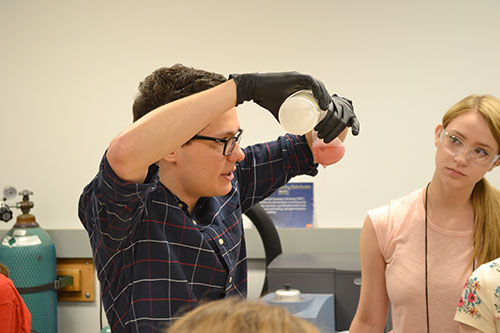
An Illinois grad student helping out with GLAM demonstrates a procedure during an activity where campers extracted DNA from strawberries. (Image courtesy of I-STEM undergrad Ryan Kim.)
“It’s not just about the campers,” Krogstad explains. “It’s also about our graduate students and our other students.” She says helping with GLAM allows them “to explore their field in a different way and look at some maybe nontraditional career paths as well.”
Krogstad says one of the most challenging thing about doing this camp is maintaining one’s energy for the whole week and “maintaining that level of dynamism and, you know, really engaging with the campers all week, right?...In spite of things that don’t go well, ‘cause they can tell.”
While she admits that the logistical stuff is also challenging, she says, “The hardest part for us to impart to the campers is the connections…synergy and intersection between different engineering fields. And this is one of the biggest challenges with a material science camp is that everything is made of material,” she explains.
Referring to the fact that materials are very diverse, with very diverse properties, she says, “We go from one activity where we’re doing soft, squishy materials, and then we switch, and all of a sudden we’re talking about the electronic properties, and it’s a very disparate sort of switch. And so it’s very important for us to find a way to illustrate those connections and really show the campers, ‘Yes, this really can all be one field.’”
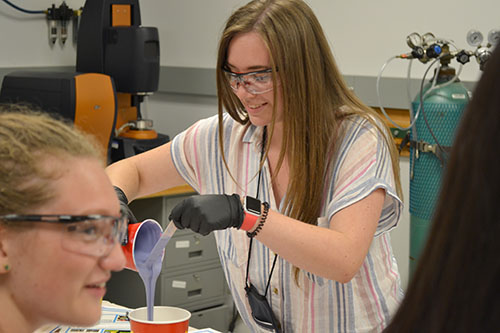
A GLAM camper does a mold-making activity. (Image courtesy of I-STEM undergrad Sooah Park.)
In fact, part of their motivation for introducing the design project in the first place was to help girls understand these connections, to give them a way to connect some ideas in their own way.
“Because we have campers who are saying, ‘This was fun, and this was fun, but I have no idea how these things are possibly connected.’ They said, ‘Well, I don’t get it, so I must not be very good at this!’”
“That’s the wrong message!” she continues. “That’s not the message that we want to be sending. So we have to be really careful and thoughtful about communicating the connective threads between all of the activities that we’re doing. Cause we really want to show them all the cool things you can do with material science without overwhelming them and making them feel like it’s just too much for them to possibly ever understand or grasp or contribute to. So that’s a really hard balance.”
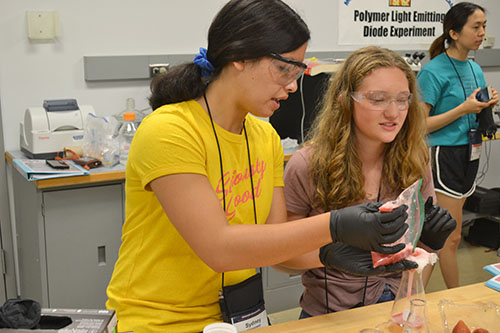
Sydney Hemenway (left) and a partner extract DNA from strawberries. (Image courtesy of Ryan Kim.)
One participant who got the message about how cool material science is was Sydney Hemenway, a rising senior at John Hersey High School in Arlington Heights, Illinois. GLAM was her first STEM camp, and she shares why she participated.
“I came here because I really like all of these sciences, and I didn’t really know what I would want to do with it, which engineering group, or how I could combine all of that. And I feel like material science has connections to all of it. It has a lot of intersectionality, and you can really get exposed to a lot of diverse subjects.”
In fact, she’s definitely considering materials engineering as a career, “Because this was really cool” she reports, “and we got to test a lot of different materials.” She appreciated getting to see all of the applications that are relevant, literally everywhere, reporting that, “Everything we do is involving materials practically.”
Hemenway says one challenge during GLAM was going back to the fundamentals, such as in chemistry, which was difuficult for the participants who hadn’t haven’t taken those sciences yet. That’s where teamwork came into play. “We all have different backgrounds,” she admits. “It was cool because we all came from different areas. We all used our own experiences to help everyone else figure it out, and we all figured it out together.”
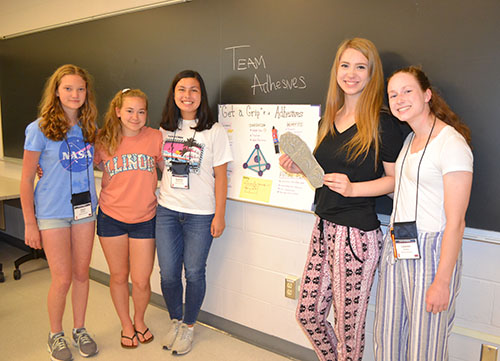
Team Adhesives shows their prototype and the poster they presented at the GLAM poster session.
Hemenway’s design project involved coming up with a novel way to use adhesives. Her team's inspiration came from teammate Liliana’s volleyball shoes. She had just purchased a new pair because her other ones had worn out on the bottom and the traction was really bad and they weren’t supposed to wash them or anything. So they figured that glue or epoxy, in their case, would work really well to give the shoe traction support and help it grip. So they developed the bottom of a shoe using glue.
Hemenway’s take on the camp? “It was just a blast!”
Another GLAM camper was Allison Lau, a rising sophomore at Glenbrook North High in Northbrook, Illinois. Lau shares why she came to GLAM.
“I’ve always been interested in science, because I just think it’s really cool about all the applications and the future for it. But I didn’t really know what I wanted to do.”
She says that when applying to camp, one can choose from a number of different disciplines. “What made material science so appealing was the fact that they said that it was like a combination of chemistry and physics, and I just really like seeing how those two seemingly different disciplines really mesh together.”
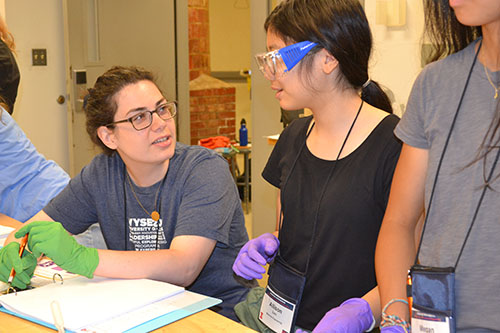 GLAM camper Allison Lau (center) interacts with MatSE grad student Jillian Carbono during an activity.
GLAM camper Allison Lau (center) interacts with MatSE grad student Jillian Carbono during an activity.While she’s had physics, she hasn’t had chemistry. “So the first day was a bit challenging because they were talking about all the stuff that I haven’t heard since eighth grade. But I think that I got used to it; they explained stuff if I didn’t get it. I think I still learned a lot. I still gained a lot from this even if there was a bit of a learning gap.”
Lau’s favorite thing about the camp was learning about X-ray Diffraction:
“Basically we use x-rays to pass through a material and then it diffracts and all these little particles come up and you can calculate the distance between them. We actually went to the lab and did that with egg proteins and I thought that was really cool.”
Regarding whether Lau might have a future in materials, she thinks it’s too early to tell. “I still want to go through high school, figure out which classes I like, that sort of stuff. But I think it is a possibility. I did really enjoy this camp. I was really interested in a lot of topics we talked about, and I could see myself looking more into it in the future.”
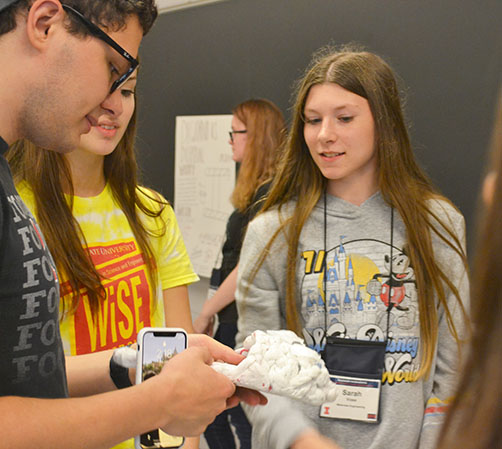
A visitor to the poster session examines the Plastic Group's prototype: the Skechie.
So how did her team come up with the idea for Skechies? When her group was first in the lab testing the properties of plastics, they learned that they are hydrophobic, oleophobic, and also very malleable. So they decided to repurpose the material into something a bit unconventional…they made a shoe using an iron to fuse plastic bags together. Their goal was twofold: to repurpose plastic bags plus possibly stimulate the economies of third world countries by providing jobs making a new product.
A rising freshman at St Bede Academy in Peru, Illinois, Madelyn Torrance came to GLAM camp to learn about engineering and decide if it might be a career option.
“Because I knew I was interested, but I kind of wanted to know if I really wanted to do it. And I’m also really interested in materials.”
In fact, when she was younger, she really liked fashion, and thought to herself, “How can I improve things, or find a career that has to do with materials and see if I can improve any of those things—make them better and more environment friendly.”
What did she think of the camp? “It’s really great,” she acknowledges. “We freeze a lot of stuff with liquid nitrogen. That’s one of my favorite parts.”
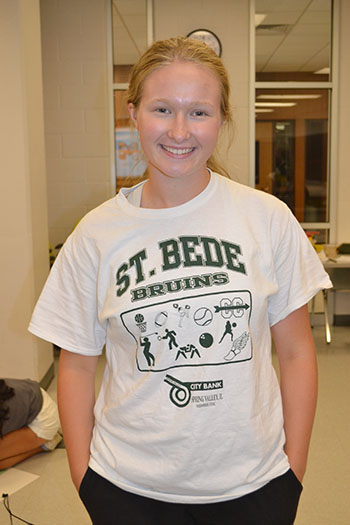
Madelyn Torrance
She also liked the lectures. “They really give a background, because I don’t know anything. I haven’t even started any chemistry courses or physics. So it really brings in some aspects of ‘Why is this working? Why is this not working?’ It’s a lot of fun. I really like it.”
She also appreciated making relationships. “I like the dorms because I’m really close to these girls from staying with them. So it’s a nice experience.” She also says she definitely intends to keep in contact with them.
Besides making her keep wanting to go into materials, she says GLAM camp gave her some perspective on materials. “It really narrowed down the different materials, because materials is such a broad area. Every engineering discipline involves materials.” She adds that the camp helped her by addressing different materials on different days, mornings, or afternoons. “So it made it easier to kind of pick and choose what I liked, what I didn’t like—something I should pursue, something I can trash.
Her overall take on the camp? “I had a great time. I’m definitely going to remember this for a while.”
Story by Elizabeth Innes, Communications Specialist, I-STEM Education Initiative. Photos by Elizabeth Innes unless otherwise noted.
More: 8-12 Outreach, GAMES, GLAM, WYSE, MatSE, Summer Camp, Women in STEM, 2019

Madelyn Torrance (center) and her fellow GLAM campers have fun with liquid nitrogen. (Image courtesy of Sooah Park.)
For additional I-STEM articles about GLAM, see:
- GLAM GAMES Uses Common—and Not-So-Common—Materials to Introduce High School Girls to Materials Science (2018)
- GLAM GAMES Camp Helps High Schoolers Explore Materials Engineering Career Options (2017)
- Girls Learn About Materials Science at the 2016 GLAM G.A.M.E.S. Camp (2016)
- GLAM Seeks to Capture Girls' Imagination About Materials (2013)

The Plastic Group by their poster with their prototype: "Skechies," shoes made entirely of plastic bags.
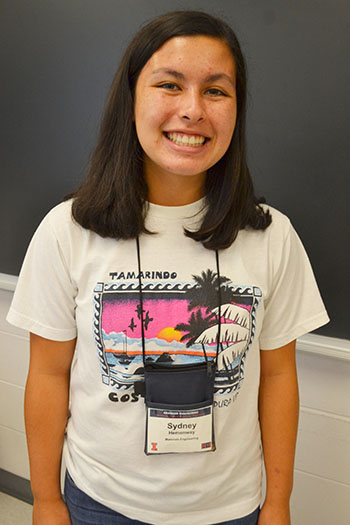
Sydney Hemenway
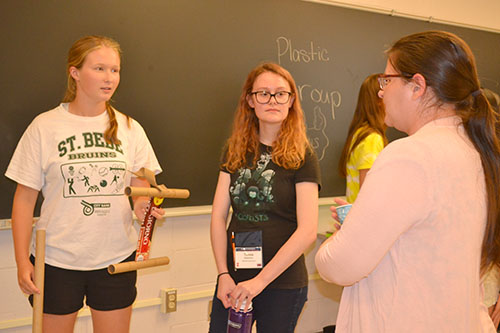
During Friday's poster session, Madelyn Torrance (left) exhibits her team's prototype, made with cardboard.
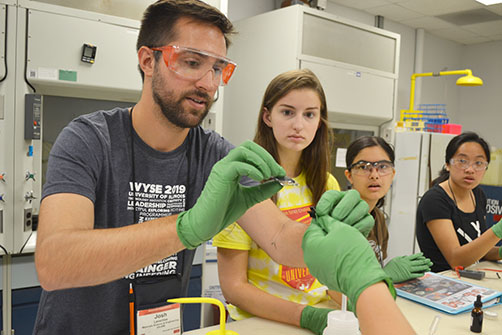
Grad student Josh Leveillee demonstrates to campers how to make a solar cell.













.jpg)
















